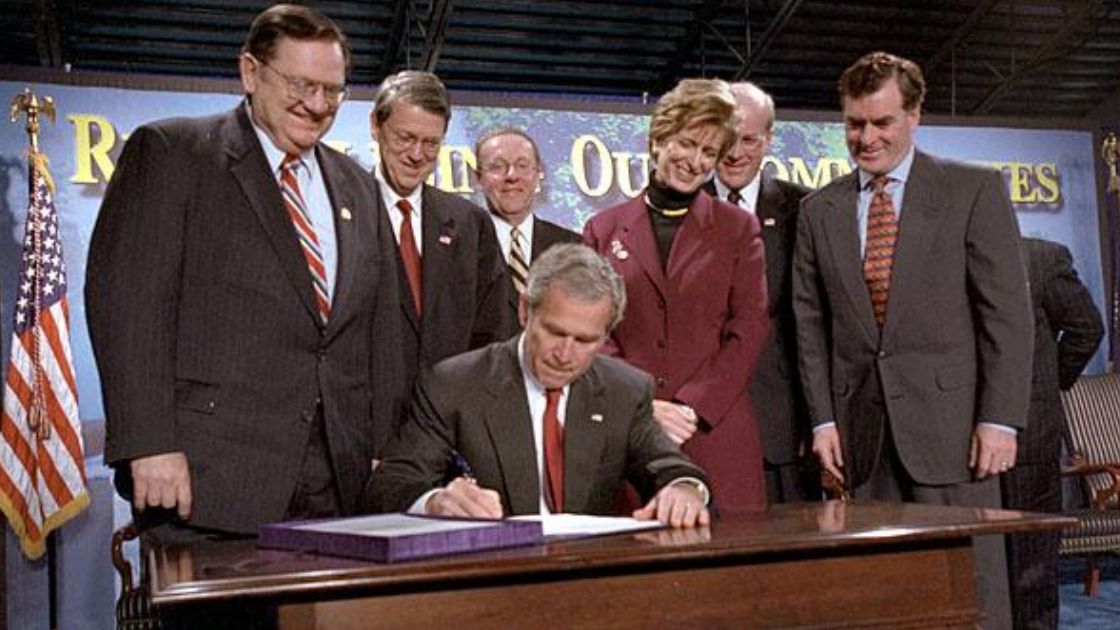It is Presidents’ Day and we decided to look into what Presidents have stopped or passed through the area. We found that since World War II, one sitting President made a stop in Conshohocken, one former President visited Whitemarsh Township, and at least two future Presidents passed through, one during the Revolutionary War and the second while campaigning. If you know of more, please let us know.
President George W, Bush
President George W. Bush made a stop in Conshohocken on January 11, 2002, to sign the Small Business Liability Relief and Brownfields Revitalization Act at Millennium. The law signed by Bush provided funds and protection to those seeking to redevelop brownfield sites. Below is a portion of Bush’s speech from that day:
The law I sign today addresses the problem of land which has already been developed, and then abandoned. American cities have many such eyesores — anywhere from 500,000 to a million brownfields are across our nation. These areas once supported manufacturing and commerce, and now lie empty — adding nothing of value to the community, and sometimes only causing problems.
Many communities and entrepreneurs have sought to redevelop brownfields. Often they could not, either because of excessive regulation or because of the fear of endless litigation. As a consequence, small businesses and other employers have located elsewhere — pushing development farther and farther outward, taking jobs with them, and leaving cities empty.
For its part, the federal government sometimes spent more time haggling over regulatory details than it did working with states and cities to fix the problem. The old way of doing things was to mandate, regulate, and litigate. That began to change a few years ago as some states, such as Pennsylvania, and some communities and local businesses began to work together, in a constructive relationship, to find positive solutions to the brownfield problem. And the federal government began to help, by pursuing a more cooperative approach — with regulatory relief, with loans and with technical support.
Here at the Millennium Corporate Center, if people take time to find out what happened, you’ll see the possibilities of what can happen when people work together. For a long time this site was the site of a steel foundry. After the foundry closed, the property sat in disrepair. Finally, with a grant from the EPA, Montgomery County began to work to turn things around. Then O’Neill came in, with private investment, and he received cooperation at every level of government. This place is a good place to work. It is now a good place to live. And there are going to be more people employed here than before. (Applause.) This is an example of what can happen, of what is possible.
And the bill I am about the sign will enable this success to be repeated many times over, all over America. It gives protection against lawsuits to prospective buyers and others who didn’t create the brownfields, but want to help clean them up and develop them. And it will help strengthen state cleanup programs, with more federal funding and less federal meddling. My budget for next year will meet this commitment by requesting that Congress double EPA’s brownfields funding.
The law will also make way for the creation of more jobs. As the employees here know, when a business develops a brownfield, it turns a stagnant plot of land into a productive neighborhood. What we ought to be asking in America is, what does it take to create more jobs? Sure, we want those who have been affected by 9/11 to be helped with an unemployment check, but what they really want is a permanent paycheck, in all public policy. (Applause.) Public policy ought to figure out ways to make sure that the entrepreneurs can succeed, so that there is job creation taking place all over the country. This is a good jobs creation bill.
Further benefit will come as businesses recycle older properties and spare surrounding lands from development. There has been a lot of talk about urban sprawl. Well, one of the best ways to arrest urban sprawl is to develop brownfields, and make them productive pieces of land, where people can find work and employment. (Applause.) By one estimate, for every acre of redeveloped brownfields, we save four and a half acres of open space.
This legislation will also protect small business owners from unwarranted Superfund liability. Lawyers and governments used to tell small business owners that because they sent their trash to a landfill — and because that landfill became contaminated — they were potentially liable for cleaning up the entire site.
When government acts in such a heavy-handed way, it hurts a lot of people, and works against its own purposes. It discourages small business growth. With this bill, we are returning common sense to our cleanup program. We will protect innocent small business owners and employees from unfair lawsuits, and focus our efforts instead on actually cleaning up contaminated sites.
Environmental protection and economic growth can go on together. It is possible for the two to exist, if we’re wise about public policy. And the law that I’m about to sign is good public policy. It’s got a lot of common sense in it. It’s wise. It encourages growth. It fosters the environment. It is the best — it shows what can — it is the best of Washington, when people decide to cooperate, not bicker, when people put the national interests ahead of political interests.
And so it’s an honor to be here in Pennsylvania, to sign the most important piece of environmental legislation that came out of the Congress last year, the Small Business Liability Relief and Brownfields Revitalization Act.
President Dwight Eisenhower
On August 24, 1966, former President Dwight Eisenhower attended the IVB-Philadelphia Golf Classic, a PGA Tour event played at the Whitemarsh Valley Country Club in Lafayette Hill from 1963 to 1980. Eisenhower was friends with Arnold Player who was playing in the tournament and handed out the trophies to the pro-am winners.
President George Washington
As General George Washington of the Continental Army in the Revolutionary War, Washington led his troops from Germantown (now part of Philadelphia) to winter quarters in Valley Forge. On the way to Valley Forge, Washington was in several communities in the surrounding area most notably Gulph Mills where he set up a headquarters from December 13 to 19, 1777.
President John F. Kennedy
While campaigning for the presidency, then-Senator Kennedy passed through West Conshohocken in late October 1960 on his way to a rally in Norristown.
Photo – The photograph of President George W. Bush and other leaders visiting Conshohocken was produced by Mr. Eric Draper and is courtesy of The White House, 2002.

